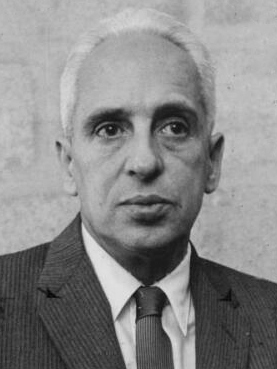Severo Ochoa facts for kids
Quick facts for kids
Severo Ochoa
|
|
|---|---|

Severo Ochoa in 1958
|
|
| Born |
Severo Ochoa de Albornoz
24 September 1905 |
| Died | 1 November 1993 (aged 88) |
| Citizenship | Spanish (1905–1956), American (1956–1993) |
| Known for | Discovery of mechanisms in the biological synthesis of RNA and DNA |
| Spouse(s) | Carmen Garcia Cobian |
| Awards |
|
| Scientific career | |
| Fields | Biochemistry, molecular biology |
| Institutions | New York University New York University School of Medicine Washington University School of Medicine |
| Influenced | Arthur Kornberg Santiago Grisolía |
Severo Ochoa de Albornoz (born September 24, 1905, died November 1, 1993) was a famous Spanish doctor and scientist who studied biochemistry. He won the 1959 Nobel Prize in Physiology or Medicine with Arthur Kornberg. They won for finding out how our bodies make important molecules called deoxyribonucleic acid (DNA) and ribonucleic acid (RNA).
Contents
Early Life and Education
Severo Ochoa was born in Luarca, a town in Asturias, Spain. His father, also named Severo Manuel Ochoa, was a lawyer and businessman. His mother was Carmen de Albornoz. When Severo was seven, his father passed away. After this, he and his mother moved to Málaga, where he finished elementary and high school.
Becoming a Scientist
Severo became very interested in biology. He was inspired by the writings of Santiago Ramón y Cajal, a Spanish brain scientist who had also won a Nobel Prize. In 1923, Severo started studying at the University of Madrid Medical School. He hoped to work with Ramón y Cajal, but Ramón y Cajal had already retired.
Instead, Severo studied with a teacher named Juan Negrín. Negrín greatly encouraged Severo and another student, José Valdecasas. He told them to try and find a substance called creatinine in urine. They succeeded and even found a way to measure tiny amounts of muscle creatinine.
Learning Abroad
In the summer of 1927, Severo went to the University of Glasgow in Scotland. He worked with D. Noel Paton to learn more about how the body uses creatine. He also improved his English skills. When he returned to Spain, he and Valdecasas wrote about their work. Their paper was quickly accepted by a science magazine, which marked the start of Severo's career in biochemistry.
Severo finished his medical degree in 1929. He decided to travel again to gain more research experience. His work on creatine led to an invitation to join Otto Meyerhof's lab in Berlin, Germany, in 1929. This institute was a very exciting place for biochemistry. Severo met many famous scientists there, including Otto Meyerhof, who had won a Nobel Prize.
In 1930, Severo returned to Madrid to finish his medical thesis. In 1931, he married Carmen García Cobián. They did not have any children. After that, he went to London, England, for more study. There, he worked on enzymes, which are special proteins that help chemical reactions happen in the body. This work was very important for his future studies.
Career and Major Discoveries
In 1933, Severo and Carmen returned to Madrid. He began studying how heart muscles use energy. Within two years, he was offered a leadership role at a new medical research institute in Madrid. However, the Spanish Civil War started around this time. Severo felt that doing research during the war would ruin his chances of becoming a good scientist. So, he and his wife decided to leave Spain.
The "Wander Years"
In September 1936, they began what Severo later called his "wander years." They traveled from Spain to Germany, then to England, and finally to the United States. This journey took four years.
Severo first went back to Otto Meyerhof's institute, which had moved to Heidelberg, Germany. The lab's focus had changed a lot. It was now one of the best places in the world for studying biochemistry. Instead of just watching muscles move, they were now cleaning and studying the enzymes involved in muscle action.
From 1938 to 1941, he worked at the University of Oxford in England. He held different positions and worked with many scientists.
Moving to the United States
In 1940, Severo Ochoa moved to the United States. He worked at several universities there. From 1940 to 1942, he was at Washington University School of Medicine. In 1942, he joined the New York University School of Medicine. He became a professor of biochemistry there in 1954 and led the biochemistry department.

In 1956, Severo Ochoa became an American citizen. He was chosen to be a member of important science groups in the United States. In 1959, he and Arthur Kornberg won the Nobel Prize. They received it for discovering how living things make RNA and DNA. These molecules are like blueprints for life.
Severo Ochoa continued his research on how proteins are made and how RNA viruses copy themselves until 1985. Then, he returned to Spain, which was now a democratic country. He worked as a science advisor there. He also received the U.S. National Medal of Science in 1978.
Severo Ochoa passed away in Madrid, Spain, on November 1, 1993. His wife, Carmen García Cobián, had died in 1986.
Legacy and Recognition
Severo Ochoa's work had a lasting impact on science. Many things have been named in his honor:
- A research center outside Madrid, the Centro de Biología Molecular Severo Ochoa.
- A hospital in Leganés, Madrid, and the Madrid Metro station that serves it, Hospital Severo Ochoa.
- The asteroid 117435 Severochoa.
- In 2003, the Spanish Post Office issued a stamp honoring him.
- In June 2011, the United States Postal Service also issued a stamp for him as part of their American Scientists collection.
- The main road into the tourist resort of Benidorm is named Avenida Dr. Severo Ochoa.
Images for kids
See also
 In Spanish: Severo Ochoa para niños
In Spanish: Severo Ochoa para niños



